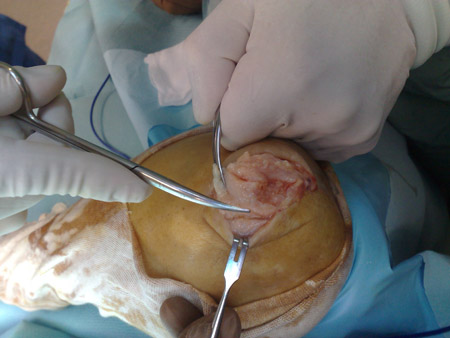Approach
The principles of treatment remain the same regardless of the anatomic location of the inflamed bursa. However, there is little robust clinical evidence to support these strategies.
Conservative management
The first step in the treatment of nonseptic bursitis is to modify activity and lifestyle to minimize mechanical stress on the inflamed bursa.[9] This involves avoiding activities that worsen symptoms (e.g., kneeling with prepatellar bursitis) and protecting the area where possible (e.g., kneepads to help avoid further trauma in prepatellar bursitis). Many patients with trochanteric and infrapatellar bursitis find crutches or a walking stick useful. It is also advisable to try to identify any predisposing risk factors that can be corrected to reduce the chance of recurrence, such as leg length discrepancy in trochanteric bursitis. It is important to rest the affected area to allow the inflammation to settle, but physical therapy may also be of benefit. Evidence from controlled trials to recommend a particular regimen is lacking; the duration of rest, and type and intensity of exercise, is patient dependent. This combination of activity modification, intermittent rest, and physical therapy is often effective.
Ice may be used in the first 24 hours to reduce swelling. It can be applied topically to the area for 10 minutes at a time, every few hours (but not directly onto the skin; a thin towel is placed between ice and skin).
Simple analgesia such as acetaminophen or nonsteroidal anti-inflammatory drugs (NSAIDs) may also be required. Topical NSAIDs may be tried initially in preference to systemic NSAIDs if acetaminophen is insufficient. In patients with olecranon bursitis there is a risk of recurrence. Because treatments like aspiration and aspiration with steroid injection can cause complications, compression bandaging and a short course of NSAIDs may offer the most appropriate balance of safety and efficacy.[19]
Corticosteroid injections
This is a second-line treatment when conservative management has not controlled symptoms.[20][21][22][23] It can be used in any type of bursitis, but injections into the retrocalcaneal bursa are considered more dangerous due to the risk of tendon rupture and should be considered with caution. Ultrasound guidance can be helpful if a deep bursa is affected. Aseptic technique is important to prevent secondary infection.
Corticosteroid injections are not recommended in septic bursitis.
Surgery
If all other modalities do not control symptoms, surgery may be considered to remove the bursa (bursectomy).[5][6][7][8] In subacromial bursitis this may be performed with a subacromial decompression.[10][11] At the hip joint, removal of the deep trochanteric bursa has no detrimental effect and may be performed endoscopically.[24] Surgery is considered a last resort for bursitis when conservative management has failed.[25]
Surgical options for retrocalcaneal bursitis are considered after 3 to 6 months if conservative management has not controlled symptoms. Surgery specific to retrocalcaneal bursitis entails debridement of the calcific or diseased portion of the Achilles insertion, excision of the retrocalcaneal bursa, and resection of Haglund deformity, if indicated. Various surgical procedures have been described that adhere to these principles.[26][27][Figure caption and citation for the preceding image starts]: Intraoperative view of an olecranon bursectomyFrom the personal collection of Nicola Maffulli, MD, MS, PhD, FRCS(Orth); used with permission [Citation ends]. Surgery is recommended rarely for isolated trochanteric bursitis and conservative treatment should be preferred.[28]
Surgery is recommended rarely for isolated trochanteric bursitis and conservative treatment should be preferred.[28]
Treatment of septic bursitis
Uncomplicated superficial septic bursitis responds well to needle aspiration of the bursa and appropriate antibiotic therapy. This can usually be done on an outpatient basis, but review is recommended every few days to monitor the effectiveness of therapy. Repeat aspiration may be indicated if swelling, tenderness, and erythema recur. If additional comorbidities are present or the patient is systemically unwell, intravenous therapy is recommended. The duration of antibiotic administration may range from 1 to 4 weeks depending on individual response. Initial antimicrobial therapy should cover staphylococci and streptococci. Cefazolin or penicillinase-resistant penicillin, such as oxacillin or dicloxacillin, is appropriate for the initial management in most patients. Clarithromycin and erythromycin are oral alternatives for penicillin-allergic patients, although some resistance has been reported.[29] In these cases, treatment with intravenous vancomycin is advised. Gram staining and culture from bursal fluid aspirate will direct specific antibiotic therapy.[17]
Supportive management with activity modification and analgesia is offered alongside antibiotic therapy following aspiration.
A further role for surgery exists with infected bursitis when surgical lavage and debridement may be indicated to reduce bacterial load. This may be required if needle aspiration has not adequately drained the bursa, if an abscess is present, or if a sinus has formed.
Use of this content is subject to our disclaimer